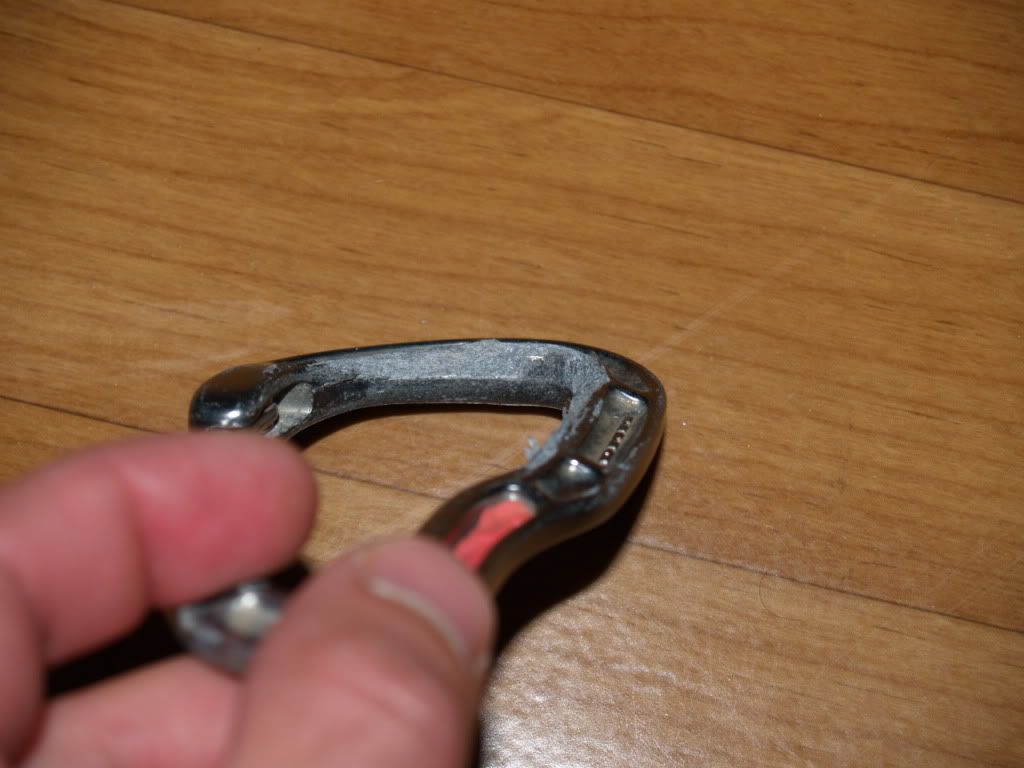Penguin
New member
The story of four DMM Shield wire-gate alloy karabiners...
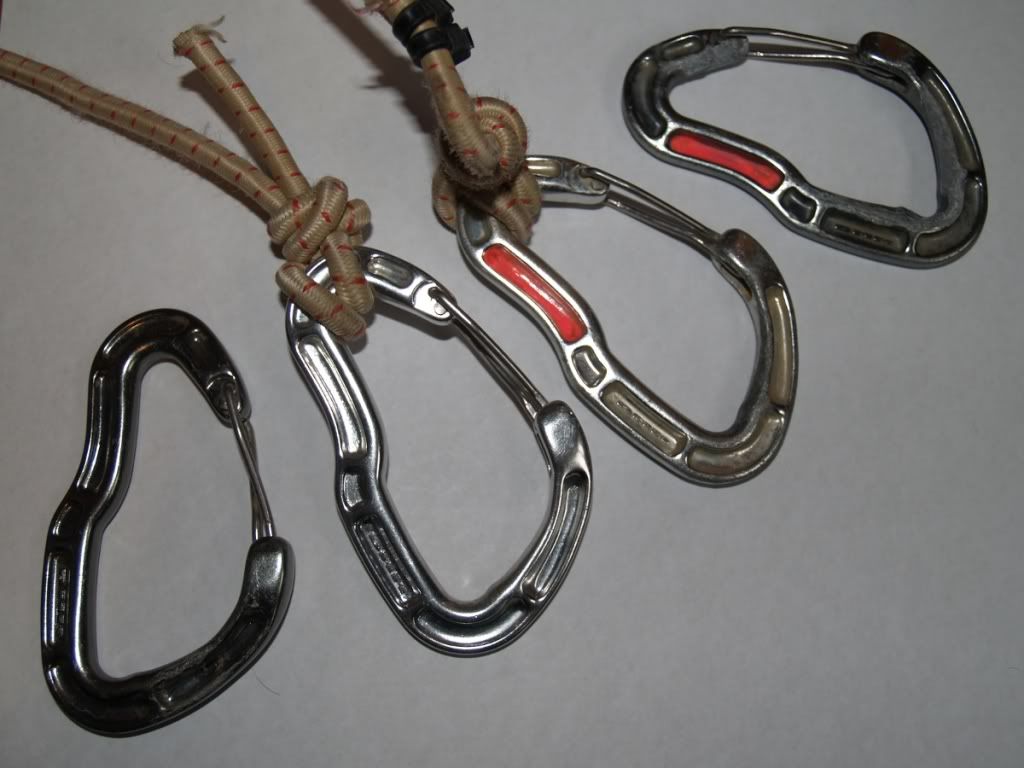
As named below, left to right: the grey, the silver, the silver-pink, and the grey-pink (the grey colouring i think is anodising of some sort, the silver ones seem to be self-coloured and uncoated).
Grey and silver were a pair on a quickdraw, grey-pink and silver-pink were also a pair on a quickdraw. The ones with pink marking were bought first, the unmarked ones second, with maybe 12 months between them. Both pairs were bought from the same shop and i think came from the same stock order.
The pink marked ones were fitted to the bungees on my sidemount harness. When used in the sea the harness was always washed in fresh water. When used in 'fresh' (i.e. peaty cave) water the harness wasn't always washed unless it was muddy. Whether washed or not the harness was either dried outside or in a warm garage in an open box - it was never stored damp in a sealed container or bag. In between uses the harness was stored in an open box in a warm garage. Sometimes the karabiners were left clipped to the stainless steel D rings on the harness.
The grey-pink one corroded rapidly after a sea dive in late 2010. After three weeks of careful storage although clipped to a SS D ring, it looked like this:
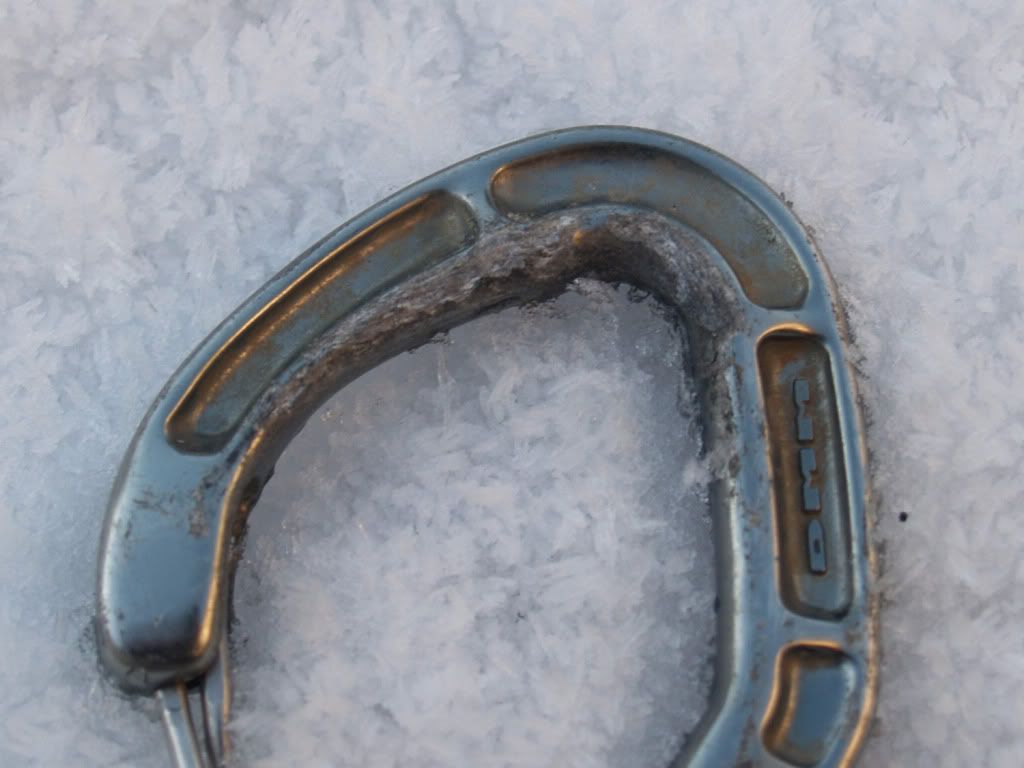
Its brother, the silver-pink one, was treated in exactly the same way but showed very little corrosion (also clipped to a D ring during the same three week storage period).
After the corrosion appeared on the grey-pink one i often made sure they were touching no other metal in storage nor each other. I left them on the harness and continued to use them both equally. (I bought the other pair to use on bottles.) Tonight i decided to replace the grey-pink one. This is how they look now (remember, both have been treated exactly the same):
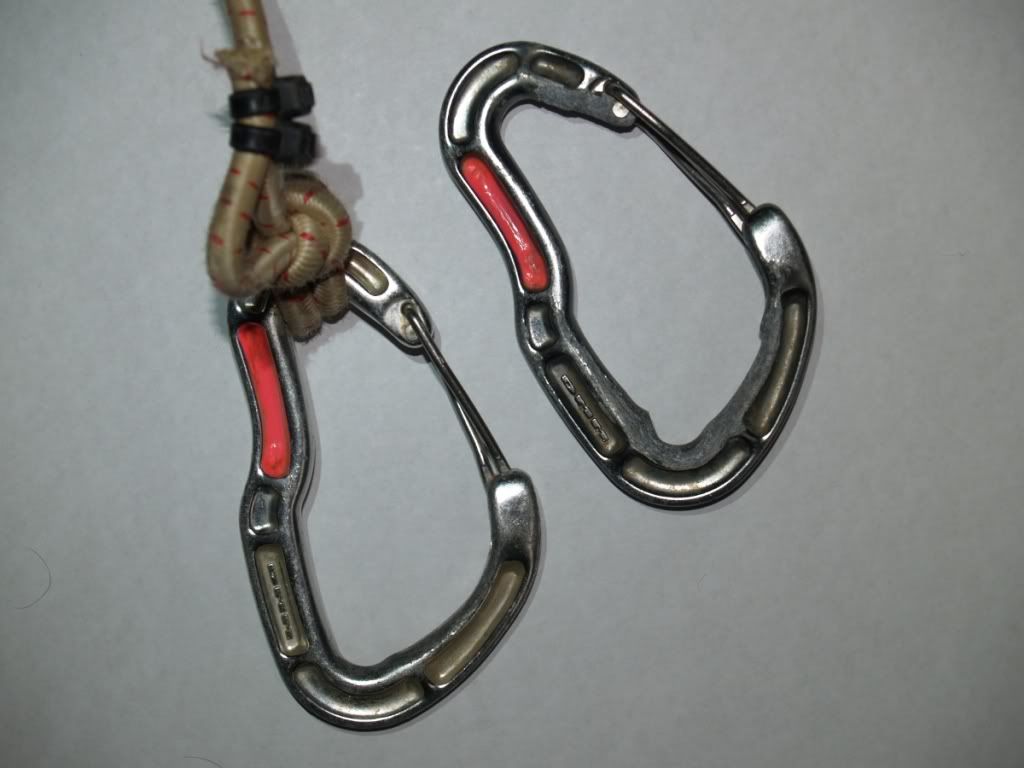
Silver-pink (still on bungee), grey-pink removed.
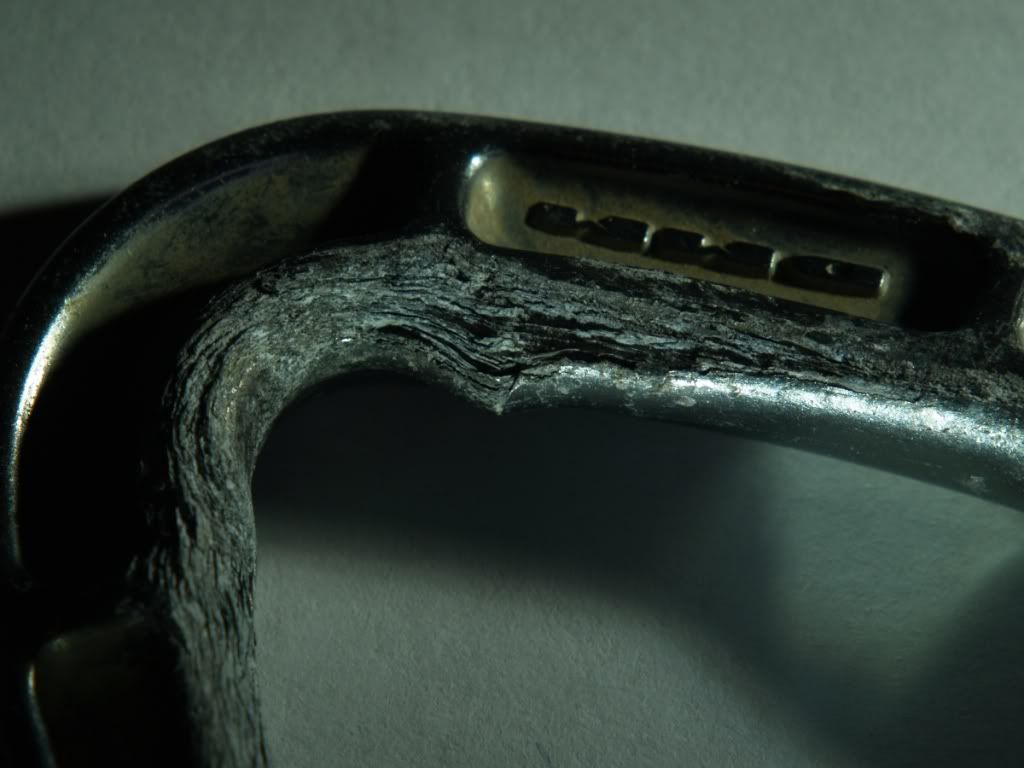
Grey-pink detail of corrosion around wide end (the end that i clip to the D ring when diving).

Grey-pink detail of corrosion around the gate hinge (part of this area was wrapped in the bungee in use).
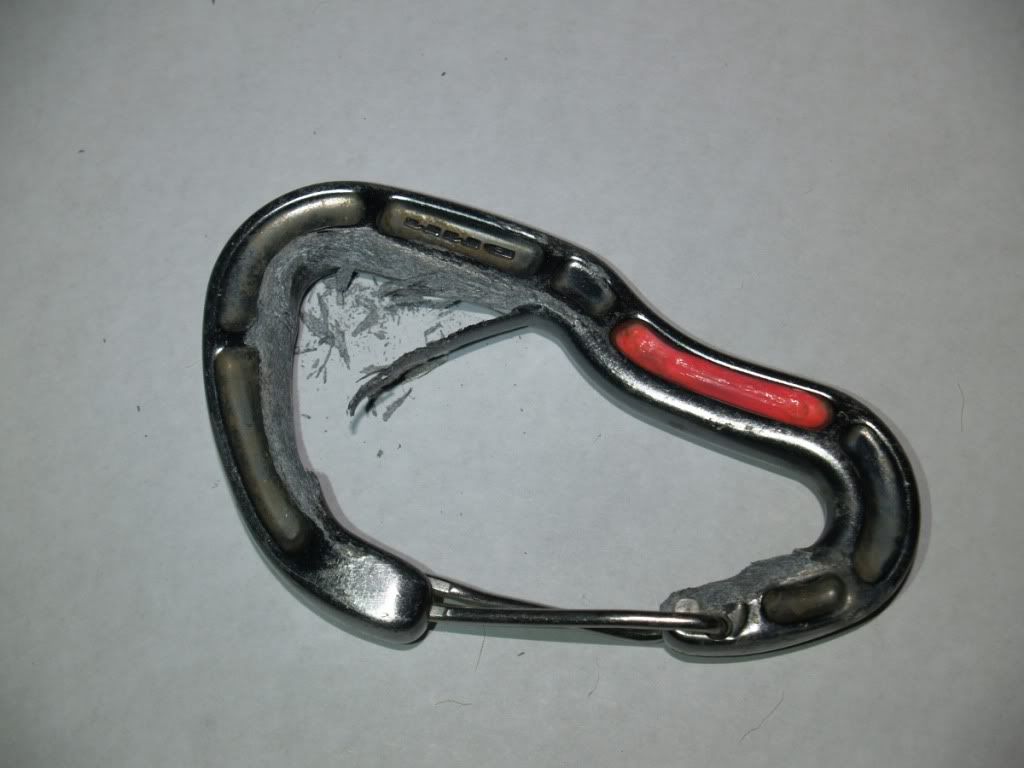
And the grey-pink corrosion after a wee poke.
What's interesting about the corrosion on this pair, and makes me now wonder about ascribing it solely to galvanic corrosion between the alloy and SS hardware, is that it's largely confined to the grey coloured karabiner and is very limited on the silver karabiner (i'd almost use the silver one on a cowstail, if i didn't know its history and its brother's history). Even more peculiarly, i looked closer tonight, and the corrosion is confined largely to one side of the grey karabiner, and appears to me to be more related to the forging of the karabiner (note the pronounced separation between good and bad metal, and the 'delamination' of the corroded metal).
The reverse side (the side without the DMM marking) of the grey-pink karabiner:
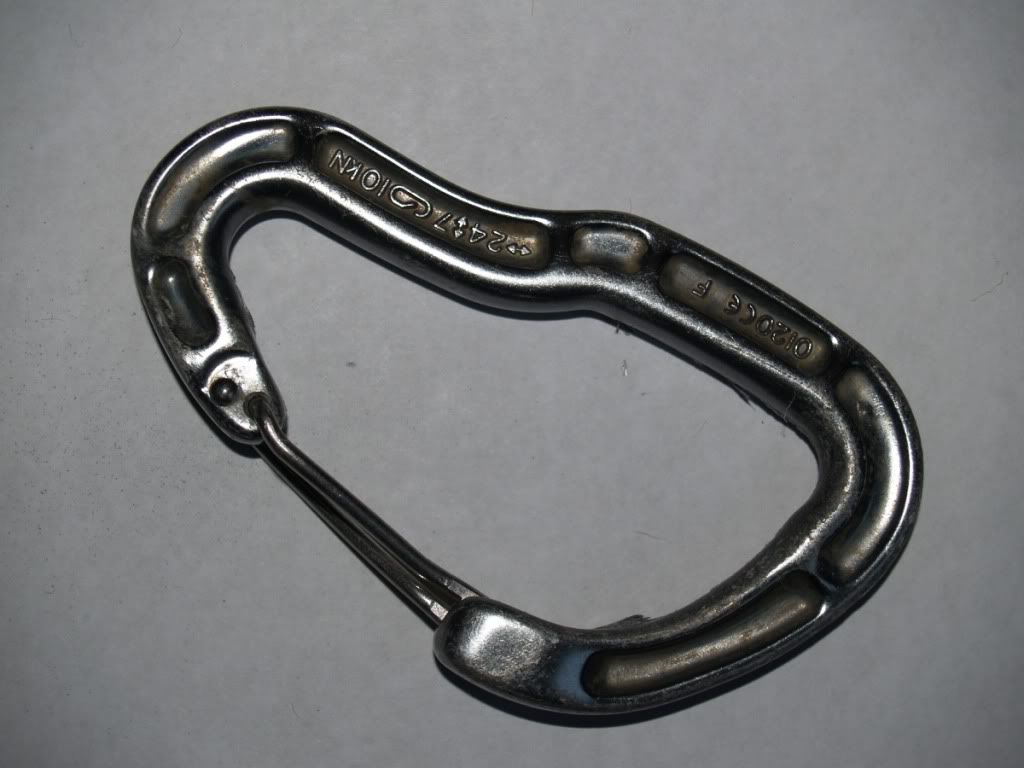
Here's a close-up of the broad end of the silver-pink karabiner for comparision:
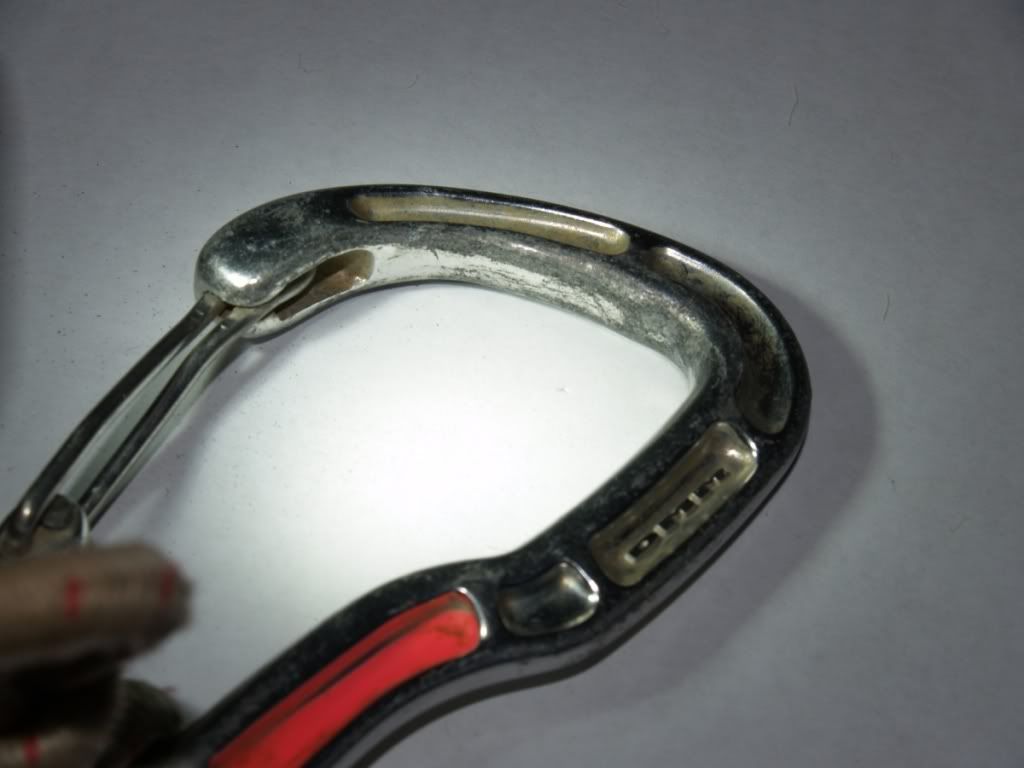
And the same area on the silver karabiner (one of the newer pair, fitted tonight to the harness bungee in place of the grey-pink):

The two non-pink-marked karabiners have been used once or twice for climbing (until the grey-pink started corroding), and once or twice on tackle bags, maybe once or twice on bottles in fresh water. On the whole they've had a much more gentle life than the pink marked ones.
Here's a close-up of the grey karabiner, penknife blade pointing out the slight beginnings of corrosion (no corrosion is visible on its silver brother):

If you have any of these karabiners used anywhere as critical components you might want to check them... :-\

As named below, left to right: the grey, the silver, the silver-pink, and the grey-pink (the grey colouring i think is anodising of some sort, the silver ones seem to be self-coloured and uncoated).
Grey and silver were a pair on a quickdraw, grey-pink and silver-pink were also a pair on a quickdraw. The ones with pink marking were bought first, the unmarked ones second, with maybe 12 months between them. Both pairs were bought from the same shop and i think came from the same stock order.
The pink marked ones were fitted to the bungees on my sidemount harness. When used in the sea the harness was always washed in fresh water. When used in 'fresh' (i.e. peaty cave) water the harness wasn't always washed unless it was muddy. Whether washed or not the harness was either dried outside or in a warm garage in an open box - it was never stored damp in a sealed container or bag. In between uses the harness was stored in an open box in a warm garage. Sometimes the karabiners were left clipped to the stainless steel D rings on the harness.
The grey-pink one corroded rapidly after a sea dive in late 2010. After three weeks of careful storage although clipped to a SS D ring, it looked like this:

Its brother, the silver-pink one, was treated in exactly the same way but showed very little corrosion (also clipped to a D ring during the same three week storage period).
After the corrosion appeared on the grey-pink one i often made sure they were touching no other metal in storage nor each other. I left them on the harness and continued to use them both equally. (I bought the other pair to use on bottles.) Tonight i decided to replace the grey-pink one. This is how they look now (remember, both have been treated exactly the same):

Silver-pink (still on bungee), grey-pink removed.

Grey-pink detail of corrosion around wide end (the end that i clip to the D ring when diving).

Grey-pink detail of corrosion around the gate hinge (part of this area was wrapped in the bungee in use).

And the grey-pink corrosion after a wee poke.
What's interesting about the corrosion on this pair, and makes me now wonder about ascribing it solely to galvanic corrosion between the alloy and SS hardware, is that it's largely confined to the grey coloured karabiner and is very limited on the silver karabiner (i'd almost use the silver one on a cowstail, if i didn't know its history and its brother's history). Even more peculiarly, i looked closer tonight, and the corrosion is confined largely to one side of the grey karabiner, and appears to me to be more related to the forging of the karabiner (note the pronounced separation between good and bad metal, and the 'delamination' of the corroded metal).
The reverse side (the side without the DMM marking) of the grey-pink karabiner:

Here's a close-up of the broad end of the silver-pink karabiner for comparision:

And the same area on the silver karabiner (one of the newer pair, fitted tonight to the harness bungee in place of the grey-pink):

The two non-pink-marked karabiners have been used once or twice for climbing (until the grey-pink started corroding), and once or twice on tackle bags, maybe once or twice on bottles in fresh water. On the whole they've had a much more gentle life than the pink marked ones.
Here's a close-up of the grey karabiner, penknife blade pointing out the slight beginnings of corrosion (no corrosion is visible on its silver brother):

If you have any of these karabiners used anywhere as critical components you might want to check them... :-\



